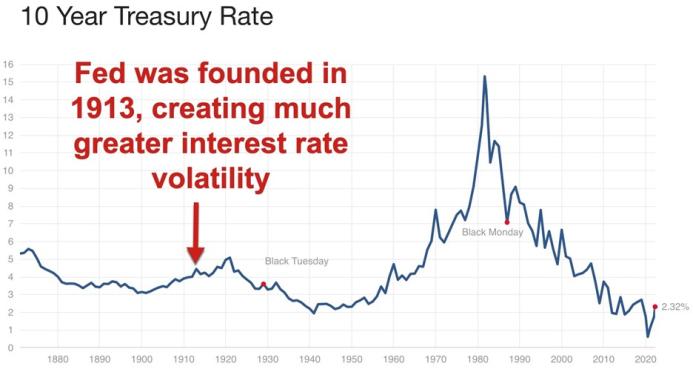Many economic commentators regard high level of debt relative to GDP as a major risk factor as far as economic health is concerned. This way of thinking has its origins in the writings of the famous American economist Irving Fisher. According to Irving Fisher,[1] a high level of debt relative to GDP runs the risk of setting in motion deflation and in turn a severe economic slump. On this way of thinking, the high level of debt sets in motion the following sequence of events that culminate in a severe economic slump.
Stage 1: The debt liquidation process is set in motion because of some random shock. For instance a sudden large fall in the stock market. The act of debt liquidation forces individuals into distressed selling of assets.
Stage 2: Because of the debt liquidation, the money stock starts shrinking and this in turn slows down the velocity of money.
Stage 3: A fall in money leads to a decline in the price level.
Stage 4: The value of people’s assets falls whilst the value of their liabilities remains intact. This results in a fall in the net worth, which precipitates bankruptcies.
Stage 5: Profits start to decline and losses emerge.
Stage 6: Production, trade and employment are curtailed.
Stage7: All this leads to growing pessimism and a loss of confidence.
Stage 8: This in turn leads to the hoarding of money and a further slowing in the velocity of money.
Stage 9: Nominal interest rates fall, however, because of a fall in prices real interest rates rise.
Note that the critical stage in this story is the stage 2 i.e. debt liquidation results in a decline in the money stock. However, why should debt liquidation cause a decline in the money stock?
Take a producer of consumer goods who consumes part of his produce and saves the rest. In the market economy, our producer can exchange the saved goods for money. The money that he receives can be seen as a receipt as it were for the goods he produced and saved. The money is his claim on these goods.
He can then make a decision to lend his money to another producer through the mediation of a bank. By lending his money the original saver i.e. lender, transfers his claims on real savings to the borrower.
The borrower can now exercise the money i.e. the claims, and secure consumer goods that will support him whilst he is engaged in the production of other goods, let us say the production of tools and machinery.
Observe that once a lender lends his money he relinquishes his claims on real goods for the duration of the loan.
Can the liquidation of credit, which is fully backed by savings, cause a decline in the money stock? Once the contract expires on the date of maturity, the borrower returns the money to the original lender. As one can see the repayment of the debt, or debt liquidation, does not have here any effect on the stock of money.
Things are, however, different when a bank uses some of the deposited money and lends them out. The owner of deposited money continues to exercise demand for money – he did not relinquish his claims on real savings in favour of a borrower.
Hence, when a bank uses some of the deposited money the bank effectively creates another claim on real savings.
Whilst in the case of fully backed credit the borrower, so to speak, secures goods that were produced and saved for him. This is however, not so with respect to unbacked credit. No goods were produced and saved here.
Consequently, once the borrower exercises the unbacked claims this must be at the expense of the holders of fully backed up claims. The bank here creates money out of “thin air”.
On the date of maturity of the loan once the money is repaid to the bank this type of money must disappear since it never existed as such and never had a proper owner.
Money supply and the pool of funding
The point that must be emphasised here is that the fall in the money stock, that precedes price deflation and an economic slump is actually triggered by the previous loose monetary policies of the central bank and not the liquidation of debt as such.
It is loose monetary policy, which provides support for the creation of unbacked credit. (Without this support, banks would have difficulties practicing fractional reserve lending).
The unbacked credit in turn leads to the reshuffling of real funding from wealth generators to non-wealth generators.
This in turn weakens the ability to grow the pool of real funding and in turn weakens the economic growth. Note that the heart of the economic growth is the pool of real funding or the ‘subsistence fund’.
According to Bohm-Bawerk,
The entire wealth of the economical community serves as a subsistence fund, or advances fund, from this, society draws its subsistence during the period of production customary in the community.[2]
Similarly, von Strigl wrote,
Let us assume that in some country production must be completely rebuilt. The only factors of production available to the population besides labourers are those factors of production provided by nature. Now, if production is to be carried out by a roundabout method, let us assume of one year’s duration, then it is self-evident that production can only begin if, in addition to these originary factors of production, a subsistence fund is available to the population which will secure their nourishment and any other needs for a period of one year. . . . The greater this fund, the longer is the roundabout factor of production that can be undertaken, and the greater the output will be. It is clear that under these conditions the “correct” length of the roundabout method of production is determined by the size of the subsistence fund or the period of time for which this fund suffices.[3]
Because of prolonged and aggressive loose monetary and fiscal policies, a situation can emerge when the pool of real funding starts shrinking. There are now more activities that consume real wealth than activities that produce real wealth. Once the pool of funding starts falling then anything can trigger economic collapse.
Obviously when things are starting to fall apart banks try to get their money back. Once banks get their money (credit that was created out of “thin air”) and do not renew loans the stock of money must fall.
Note however that the consequent price deflation and the fall in the economy is not caused by the liquidation of debt as such, nor by the fall of money but by the fall in the pool of real funding on account of previous loose monetary and fiscal policies.
Conclusions
Contrary to the popular way of thinking, the threat to US economy is not the high level of debt as such but loose fiscal and monetary policies that undermines the pool of real funding.
In addition, the fall in the money stock, that precedes price deflation and an economic slump is actually triggered by the previous loose monetary and fiscal policies and not the liquidation of debt as such.
Also, once the pool of funding becomes stagnant or begins to shrink, economic growth follows suit and the myth that government and central bank policies can grow the economy is shattered.
[1] Irving Fisher, Boom and Depressions, London: George Allen, p 39.
[2] Eugen von Bohm-Bawerk, The Positive Theory of Capital, Book 6, chapter 5, Macmillan and Co,1891.
[3] Richard von Strigl, Capital & Production, Mises Institute, p 7.



